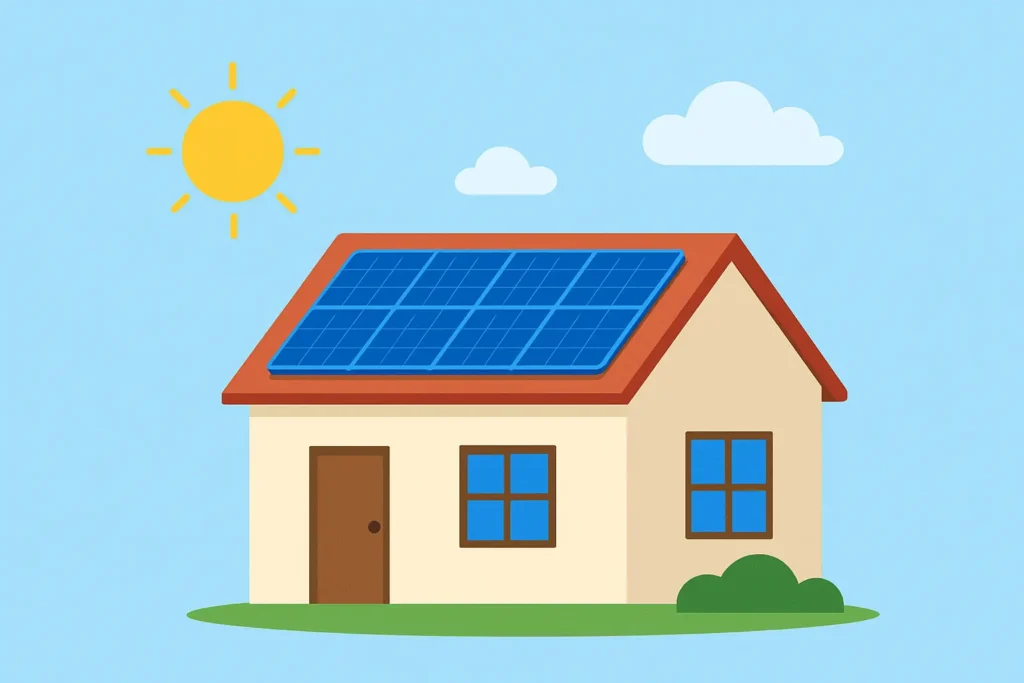Understanding the Cost of Solar Panels for a 3-Bedroom House in India
Understanding the expense of solar panels for a 3-bedroom house in India is the first step towards transitioning to renewable energy. Installing solar panels is a practical method to lower monthly electricity expenses and an environmentally responsible decision for the majority of homeowners. The cost of solar panels for a 3-bedroom house in India varies according to electricity usage, panel size, and number of appliances, but with the appropriate setup, families can save significantly.

To calculate the cost of solar panel installation for home, one needs to know the following:
Household Electricity Usage for a 3-Bedroom House
The average energy use of a three-bedroom house in India is about 400 to 700 units per month, though this might vary. During the monsoon season, power usage is normally reduced; however, in the summer months, it might rise due to increased use of air conditioning and other appliances.
Many homes often spend between ₹2,500 and ₹3,000 a month on power.
- The average monthly payment for a home with one air conditioner is about ₹3,000.
- Monthly costs for a home with two air conditioners can reach ₹7,000.
- The monthly expenses of a home with three air conditioners that are always in use could amount to ₹13,000.
Monthly power usage is typically half of bimonthly consumption, allowing homeowners to better estimate their needs.
Monthly Power Usage for a 3 Bedroom House in India
If a residence consumes 3 kW of power, it is advised that a 5 kW solar panel system be installed to provide adequate power backup and meet peak usage. Variations in sunlight, weather, and seasonal use are partially offset by this extra capacity.
A 5 kW solar panel system can easily power the majority of a 3-bedroom home’s demands, such as fans, lighting, kitchen appliances, and air conditioners, while also lowering reliance on grid electricity.
Solar Capacity Needed for a 3 Bedroom House in Kerala
A typical 3-bedroom home should have a minimum of a 5 kW solar system installed, although the exact capacity varies significantly depending on the number of air conditioners used. While a two-AC household typically needs a 5 kW system, a single air conditioner can get by with a 3 kW system. Homes with three or more air conditioners may require a 7 kW or larger system, depending on their total electricity consumption.
Number of Panels Required
The number of panels required will vary depending on the system size. A 3 kW system typically requires six panels, while a 5 kW system requires nine, and a 7 kW system requires twelve.
Market Price for Solar Panels in Kerala
In Kerala, a 3 kW rooftop solar system for a flat roof typically costs between ₹2.15 Lakh and ₹2.20 Lakh after incentives. Additional modification fees could be incurred by clients who need custom installations. KSEB requires a refundable deposit, which is reimbursed to the client following system commissioning. Complex design, such as five-story structures or sophisticated electrical connections, may result in an increase in installation fees. This cost provides a broad guideline for Kerala households considering on-grid solar options.
Government Subsidies & Policies
Government incentives are offered for home solar panels with capacities of up to 10 kW. For a 1 kW system, the subsidy amount is approximately ₹30,000; for a 2 kW system, it is about ₹60,000; and for a 3 kW system, the subsidy is around ₹78,000. Subsidies for systems larger than 3 kW are still limited to ₹78,000. Subsidies are most appropriate for systems ranging between 1 and 5 kW, as the cost of panels under the subsidy plan tends to be greater than commercial panel prices.
For homeowners planning a 5 kW system, opting for a subsidy option may not always be advantageous because of the greater panel rates. However, subsidies are a great option if you intend to take out a bank loan because the financial assistance makes payments simpler. Most Indian banks now offer solar loans under the PM Surya Ghar initiative, making the shift to solar energy more affordable and accessible to households.
Why Neal Solar is the Best Solar Panel Installation Company in Kerala
We provide customized solar systems made to meet each household’s particular requirements. Our services are actively offered throughout districts, including Idukki, Ernakulam, Kottayam, Pathanamthitta, Thrissur, Kollam, and Thiruvananthapuram, guaranteeing trustworthy and effective solar installations for clients in these regions.
Solar Payback Period
Solar energy investments yield high financial returns. Customers can anticipate a payback period of approximately three years, depending on the type of system and their energy usage.
Solar Systems & Components
We provide on-grid, off-grid, and hybrid solar systems to meet a variety of applications, as well as tubular and lithium batteries for dependable energy storage. Our solutions maximize efficiency and guarantee reliable performance by utilizing sophisticated microinverters.
Conclusion
Investing in a solar panel system for a three-bedroom house in India is both a step toward sustainable living and a sound financial move. An on-grid, off-grid, or hybrid system, along with appropriate battery and inverter choices, can help homes drastically lower their electricity costs while maintaining a steady source of power. With subsidies and reasonable market pricing in Kerala, setting up a 3 kW solar system is now more affordable than ever, providing long-term savings and environmental advantages.
FAQs
Are there loan schemes available for solar panels in Kerala in 2025?
Yes, various banks and financial organizations in Kerala provide credit packages expressly for rooftop solar installations, allowing homeowners to spread the cost over time while benefiting from incentives.
What is the typical payback period for solar panels in Kerala?
For a conventional 3 kW system, the payback period is usually around 3 to 5 years, depending on electricity consumption, system size, and usage patterns.
How does the cost of grid-tied and off-grid solar systems compare in Kerala?
In general, grid-tied systems are less expensive and better at lowering electricity costs, whereas off-grid systems are more expensive since they require batteries and other equipment, which makes them perfect for isolated areas without grid access.
Types of solar panels available in kerala
Monocrystalline, Polycrystalline, and Thin-film panels. To know more, read our detailed blog about different solar panel types and their efficiency.
